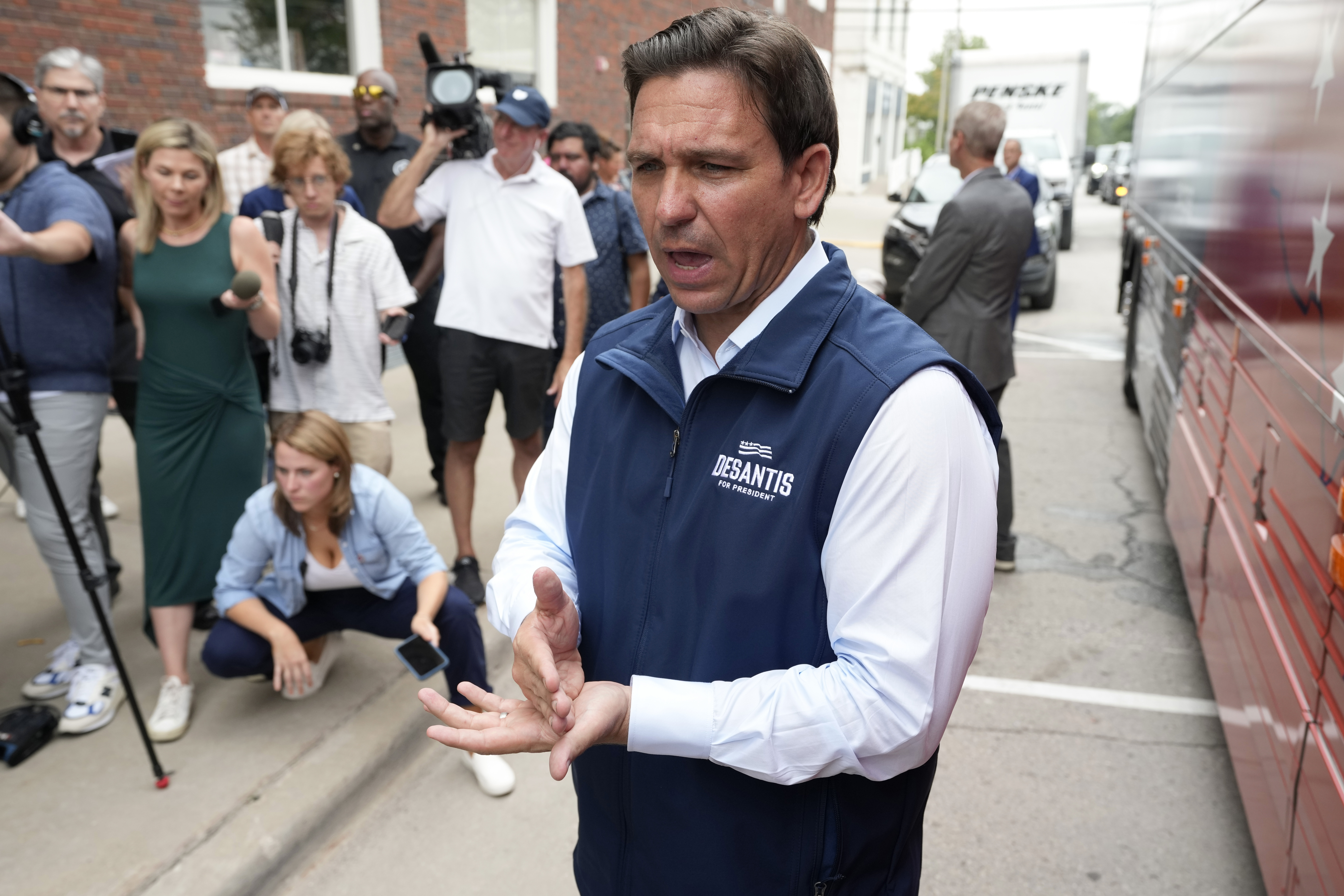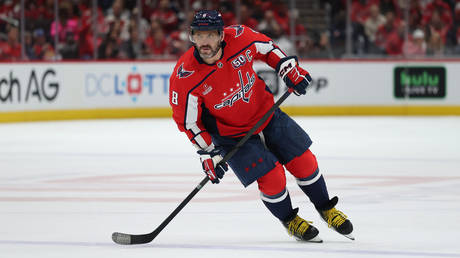A DeSantis come-from-behind win is looking vanishingly unlikely
Candidates overcoming the kind of deficit the Florida governor faces have a grim track record.


Americans say they love a good comeback story — and Ron DeSantis' only hope is that they do.
But it’s been a minute since that worked out for a presidential candidate.
Historically, there have been a few times when presidential hopefuls come out of nowhere and snatch their party’s nomination. This happened with Jimmy Carter in 1976. Bill Clinton managed to pull off a similar feat in 1992, when the then-Arkansas governor used a second-place finish in New Hampshire to turn the page after allegations that he’d had an affair with a former local TV reporter and brand himself “The Comeback Kid.”
Lately, though, voters have been sticking with the frontrunners. That’s bad news for DeSantis and the other Republicans seeking to dethrone Donald Trump.
Only once has the Republican polling leader in midsummer of the year before the election gone on to lose the party’s nomination: Rudy Giuliani in 2008, when John McCain surged to capture the GOP nod.
When it comes to the DeSantis campaign, the McCain model remains his best-case scenario — and, indeed, the Florida governor’s recent staffing cuts are reminiscent of that 2008 campaign. But the campaign reset increasingly belies the size of the hole the Florida governor, who was once breathing down Trump’s neck, is in: Even in the early days of the primary system, when things were far more volatile, no candidate has ever blown a national polling lead even a third as large as Trump’s is today: 37 percentage points, according to FiveThirtyEight’s latest average.
A Trump collapse would be unprecedented. So, too, would a DeSantis turnaround.
So what can past primary comebacks dating back to the 1970s tell us about the prospect of a shakeup today? Here’s a ride back in history, looking at the Democrats and one single Republican who managed to reverse the tide in the year before the primaries:
2008 Republican primary
RealClearPolitics average as of July 29, 2007: Rudy Giuliani 26.3 percent, Fred Thompson 19.3 percent, John McCain 14 percent
An example of the early states playing a pivotal role, and the only Republican primary on this list. Giuliani led in national polling throughout all of 2007, though his lead was far less dominant than Trump's. But the former New York City mayor, who infamously said he was skipping Iowa and New Hampshire to focus instead on Florida, found himself slipping in the polls following the Iowa caucuses.
McCain won the New Hampshire primary and grabbed the lead in the national polling average. He never relinquished it, vanquishing Giuliani in Florida and outlasting Mitt Romney and Mike Huckabee to win the nomination.
DeSantis’ campaign team would like to repeat this feat. They hope a strong showing in Iowa will act as a catapult. And there are some parallels between DeSantis and McCain that go beyond the negative stories about their campaign apparatuses.
McCain’s public image took a hit as his campaign floundered in the summer of 2007. Gallup tracked McCain’s favorable ratings for much of his career, from 1999-2017. The first and only time more Americans said they had an unfavorable opinion of McCain than a favorable one was August 2007, and the differences between those measurements were well within the margin of error: 41 percent favorable, 42 percent unfavorable.
DeSantis has also seen his overall favorability slide during his spring and summer swoon. According to FiveThirtyEight’s polling average, DeSantis’ net favorability — that is, the difference between his average favorable and unfavorable ratings — has dropped from +1 at the start of this year to -9.8 points today.
Over that time, DeSantis’ average favorable rating slid slightly, from 37 percent to 35.6 percent. But his average unfavorable rating has risen significantly: from 36 percent on the first of the year to 45.5 percent now.
1992 Democratic primary
FiveThirtyEight average over the second half of 1991: Mario Cuomo 22.7 percent, Jerry Brown 13 percent, Doug Wilder 7.8 percent, Bill Clinton 7.4 percent
Trump and former New York Gov. Mario Cuomo might be from the same borough of New York City, but that’s where the similarities end. The current GOP frontrunner isn’t going to leave his private plane (which he calls “Trump Force One”) idling on the runway while the filing deadline passes in New Hampshire, as Cuomo famously did in December 1991, leaving the Democratic field wide open.
Clinton didn’t even enter the race officially until October 1991, and he was able to parlay the appearance of momentum after that second-place finish in New Hampshire to take down former (and future) California Gov. Jerry Brown and Sen. Paul Tsongas, whose New Hampshire victory was largely attributed to his residency in the neighboring state of Massachusetts.
1988 Democratic primary
FiveThirtyEight average over the second half of 1987: Jesse Jackson 18 percent, Gary Hart 12.7 percent, Michael Dukakis 11.3 percent
FiveThirtyEight’s average has Gary Hart ahead of the eventual nominee, Michael Dukakis, over the second half of 1987. But Hart was out of the race from May to December of that year after accusations of an extramarital affair.
Jesse Jackson, meanwhile, became the first African-American candidate to win a state’s nominating contest, capturing most of the Southern states en route to a runner-up finish. But he was below 20 percent in FiveThirtyEight’s polling average, suggesting the kind of wide-open race that doesn’t exist for Republicans this year.
1976 Democratic primary
FiveThirtyEight average over the second half of 1975: George Wallace 20 percent, Hubert Humphrey 16 percent, Henry “Scoop” Jackson 11 percent, Ed Muskie 10 percent, George McGovern 9.5 percent, Birch Bayh 2 percent, Jerry Brown 1.5 percent, Sargent Shriver 1.5 percent, Mo Udall 1 percent, Frank Church 1 percent, Lloyd Bentsen 0.8 percent, Fred Harris 0.8 percent, Jimmy Carter 0.5 percent
The FiveThirtyEight average lists a dozen Democrats ahead of Carter in its late-1975 average, with the leader by that point being the perennial Southern candidate George Wallace, who would go on to win only three Southern states: Mississippi, South Carolina and his home state of Alabama.
=
Carter was a former one-term governor of Georgia — he was ineligible to run for reelection in 1974 under the state’s term limits at the time — yearning, mostly unsuccessfully, for the kind of national profile DeSantis built for himself in Florida. The Carter campaign ended up leaning into his out-of-nowhere rise, producing a campaign video titled “Jimmy Who?”
1972 Democratic primary
FiveThirtyEight average over the second half of 1971: Ed Muskie 24.5 percent, Hubert Humphrey 18.8 percent, Ted Kennedy 18.2 percent, John Lindsay 6.7 percent, George McGovern 5.7 percent
The first primary in the modern era. Ed Muskie’s campaign was undone in equal parts by the infamous “Canuck letter” and George McGovern’s savvy campaign, led in part by Hart, a future candidate himself.
McGovern’s campaign — which the renowned political journalist Teddy White called “a masterpiece of partisan warfare” that “was to shake and change the entire Democratic Party in the [first] ten weeks” of the primaries — could serve as a possible model for DeSantis. In beating Muskie and Hubert Humphrey, McGovern took down the party’s 1968 nominees for vice president and president, respectively.
But neither Muskie nor Humphrey had the command of the early-1970s Democratic Party the way Trump has over the GOP today.
Honorable mention: Carter vs. Kennedy in 1979
When Carter was seeking reelection, then-Sen. Ted Kennedy actually led Carter in the second half of 1979, according to FiveThirtyEight’s analysis.
Kennedy, though, limped into the first primaries and caucuses. His campaign gained steam later in the calendar, but Carter won the most delegates and clinched the nomination when Kennedy conceded during that year’s Democratic convention.












